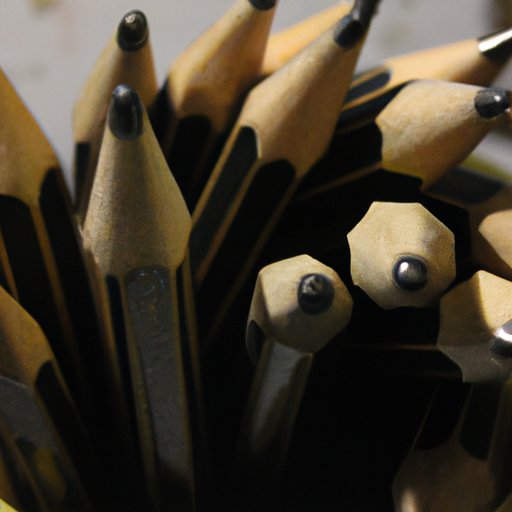Introduction
The pencil is one of the most ubiquitous tools around today. It’s used for writing, sketching, drawing, and more. But when was the pencil invented? To answer this question, we must look at the history of the pencil and trace its evolution from ancient times to the present day.
A Historical Look at the Invention of the Pencil
The earliest known pencils date back to the 16th century, when a large graphite deposit was discovered in England. Graphite, a form of carbon, was used to create the first pencils. These early pencils were made by wrapping the graphite in string or sheepskin and then shaping it into a stick. The resulting pencil was much cruder than modern pencils, but it still served its purpose as a writing tool.
It wasn’t until the late 1700s that the modern pencil was invented. Nicholas-Jacques Conte, a French officer in the military, developed a method of mixing powdered graphite with clay and then firing the mixture in a kiln. This process allowed him to create a pencil with a lead core that was much harder and more durable than the earlier pencils. Conte’s invention revolutionized the pencil industry and set the stage for the modern pencils we know today.

Tracing the History of the Pencil from Invention to Present Day
Since Conte’s invention, the pencil has undergone several changes and developments in technology. Early pencils were made with graphite, but soon other materials such as clay, wax, and even rubber were used to make pencils. This allowed for a wider variety of pencils with different lead grades and colors.
The invention of the modern pencil sharpener in 1828 also helped to popularize the pencil. Before this invention, pencils had to be sharpened by hand using a knife. The invention of the pencil sharpener made it much easier to use pencils, and they quickly became an essential tool for writers and artists.

How the Pencil Changed Writing and Art Forever
The pencil has been credited with changing the way people write and draw. Prior to the invention of the pencil, most people used quills or reed pens to write. These tools were difficult to use and could not produce the same level of detail as a pencil. With the invention of the pencil, people were able to make finer lines and create more intricate drawings.
The pencil has also had a huge impact on education. Its portability and affordability have made it a staple in classrooms around the world. Students can now easily carry pencils with them and take notes or practice writing without having to worry about running out of ink or having to sharpen their quill.

Examining the Evolution of the Pencil from Ancient Times to Today
The pencil has come a long way since its invention in the late 1700s. Pre-industrial pencils were made of graphite and clay, while modern pencils are made of a variety of materials including wood, plastic, and metal. Modern pencils also come in a range of sizes and lead grades to suit different needs.
In addition to its physical evolution, the pencil has also seen changes in its use. In the past, pencils were primarily used for writing and drawing. Today, pencils are used in a variety of ways, from taking notes to creating works of art.
Conclusion
The pencil is an incredibly versatile tool that has been around for centuries. From its humble beginnings as a crude graphite stick to its modern iterations made of a variety of materials, the pencil has evolved significantly over time. Its invention has revolutionized writing and art, and its portability and affordability have made it an invaluable tool in classrooms around the world.
Though the pencil may seem like a simple tool, its history reveals just how powerful and transformative it can be. The pencil is a testament to the power of human ingenuity and creativity, and its legacy will remain for generations to come.
(Note: Is this article not meeting your expectations? Do you have knowledge or insights to share? Unlock new opportunities and expand your reach by joining our authors team. Click Registration to join us and share your expertise with our readers.)
